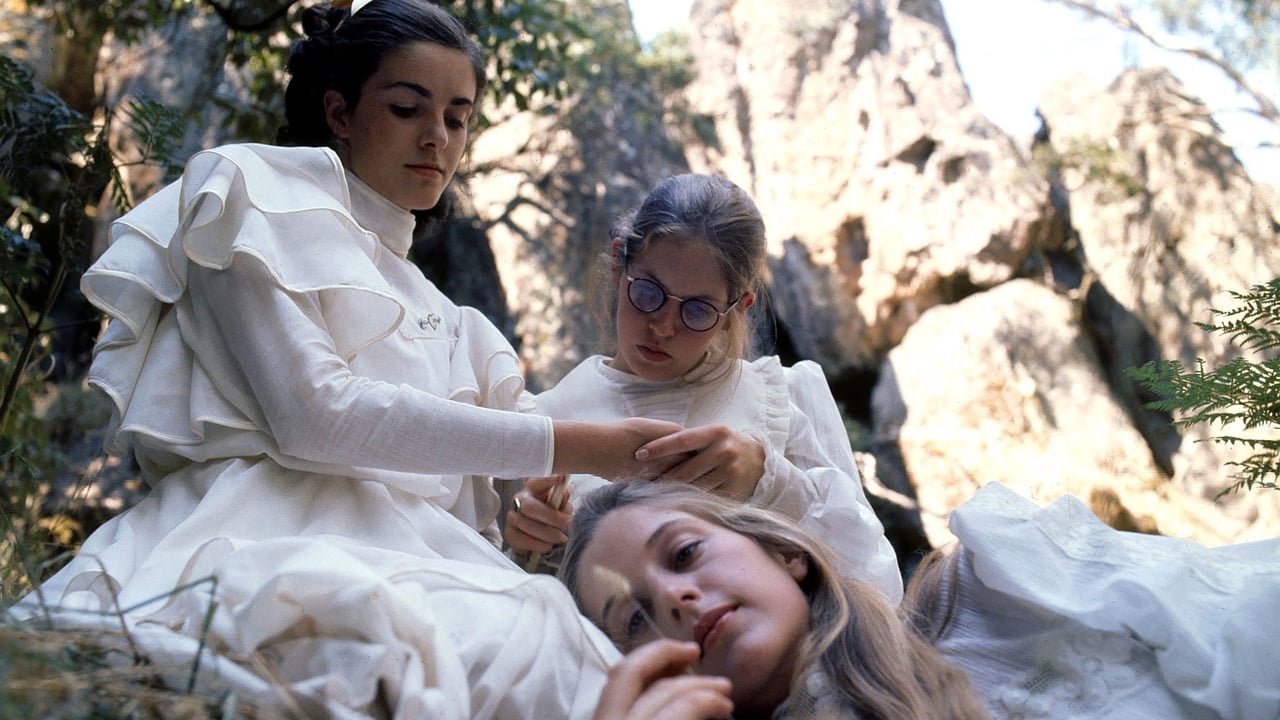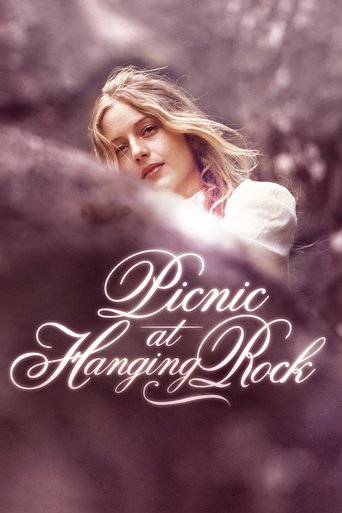

Wonderful character development!
... View MoreAmateur movie with Big budget
... View MoreThe film may be flawed, but its message is not.
... View MoreStory: It's very simple but honestly that is fine.
... View MoreDirector Peter Weir creates a dreamy feeling to this mystery of the disappearance of three schoolgirls and a teacher during a picnic at Hanging Rock, Victoria in 1900, and that's probably the key to really enjoying this film, soaking up its atmosphere. I liked the ambiguity of it all, as well as the little Victorian age touches, communing with nature and reading poetry. However, as a whole, it seemed a bit like a made-for-TV production, amateurish in places, and melodramatic in others. The whole point, of course, is that horror is more intense when it is unseen and unknown, and, like others, I see the film as a forerunner to 'The Blair Witch Project'. It was harder to appreciate moments when character actions seemed illogical or the film left loose ends dangling. It's telling to me that the original book explained the events in a very silly way (google it), but author Joan Lindsay's editor had that chapter removed. The film is entertaining, but it didn't live up to its acclaim for me.
... View MoreWhose story is this supposed to be? The only interesting people were miss McCraw who being treated like crap, and then she wanders off and we'll never hear of her again. The orphans Albert and Sara. Nothing is told about them much either. Millie and Tom. And they too are just bystanders. To someone's story. Mlle de Poitiers? She has an engagement ring, so - Nah. We will never know who she was engaged to, or what ever happened with her. Why is she in charge at the picnic? Why isn't she punished in any way for losing the girls? I suppose it's because she's SO BEAUTIFUL. That's the only reason for womenfolks to exist. At least in this movie. Except the headmistress. She is there just to be mean. Because power does that to women. And then she becomes a drunk and kills herself. Possibly. Too many people with not much to say. Is this Michael's story? Or Sgt. Bumpher's story? I don't know. I don't think Peter Weir knows.Nothing is ever solved. There's too much ESP in this movie. "I just know I won't be coming back." "I just know I have to go there". People seem to have no other reason to do what they do except that they "know".I hate the "knowing"... the girls are meaninglessly wandering about being airy fairy, talking about love and stuff and things that sound meaningful with a breathy airy light voice. The music is horrible. It's like watching these "you'll never believe these mystical unsolved bla bla bla" videos on YouTube. This one is just 100 minutes in stead of 10 minutes. The clothes... Why is everyone wearing white except the only two women with anything in their head? And then the church clothes... *sigh* Why?Make-up - what's with all these bruises and scratches? Where did he get that cut on his head?The set... was obviously a set. It didn't look like it was an actual room.What's with the butt scene? How was that in any way necessary?And the girls hopping over the brook? There was no need for the fat girl to put her foot into water, but, sure, she did, and the other three, slim, "beautiful" girls, just hopped over like gaselles. Except that Saint Miranda the Angel had to lift her skirt to show off her legs, even though she never needed to lift her skirt. *sigh*And the practically only fat girl wasn't only fat, she was lazy, whiny, stupid and ridiculous and gets slapped. That slap scene also... All the girls are on Iris, and this amazing, wonderful Mademoiselle goes find the fat girl to slap her. Cinematography... er... I don't even care. The story is so fragmented, nonsensical, stupid and boring, I really don't care if it even has any technical value. I give it 2 only because I've seen worse movies, but I don't recommend this to anyone for any reason. I'm sure there are hundreds of movies that are better use of time for any reason anyone could have for seeing this movie. Well, except if one has decided to see all Peter Weir movies. Poor you.
... View More1990. Several students from an all-female college inexplicably vanish into thin air while spending a St. Valentine's Day outing in the Australian wilderness.Director Peter Weir ably crafts a hypnotically dreamy atmosphere that's in equal degrees ethereal, enigmatic, and sinister, vividly captures the suffocating repressiveness of the early 20th century Victorian era, lets the compelling story unfold at a leisurely pace, and makes excellent and evocative use of the titular ugly and uninviting main location. Cliff Green's oblique, yet still intriguing script offers plenty of pungent criticism of the stifling zeitgeist of the Victorian period and the deep-seated need to escape from sexual and social repression into a better more permissive world.Moreover, it's superbly acted by a top-rate cast, with especially stand-out contributions from Rachel Roberts as stern headmistress Mrs. Appleseed, Anne-Louise Lambert as the sensual and entrancing Miranda, Karen Robson as the perky and fetching Irma, Jane Vallis as the nerdy Marion, Dominic Guard as the smitten Michael Fitzhubert, Christine Schuler as annoying whiny frump Edith, Kirsty Child as compassionate teacher Miss Lumley, and Margaret Nelson as rebellious troublemaker Sara. Russell Boyd's sumptuous cinematography delivers a wealth of stunning and beautiful visuals. Best of all, Weir's admirable refusal to provide some kind of explanation for the disappearances gives this film its own singularly arresting cinematic allure.
... View MorePicnic at Hanging Rock is a curious movie in my ways. The pacing is fairly slow, progressively building up to key moments within the film, while the relatively simple plot is essentially just a mystery with a few twists. However, where the movie excels is in building and diffusing tension. For example, up until the girls disappear into the rock, there are a few hints that something bad, or unusual, will happen. Firstly, there are Miranda's cryptic comments to Sara about needing to find somebody else to love, Miranda's almost ashamed look downwards when Sara waves to her (as if she knows that she'll not be returning), the birds and the horses being startled when Miranda opens the gate and time seeming to stop at the rock. That, plus the eerie atmosphere and music, builds the tension quite nicely. The same thing happens later in the film, when Sara's reaction to Miranda's disappearance, Mrs Appleyard's increasingly abusive behaviour towards her and revelations about her troubled past let you know something unpleasant is about to happen. The film also diffuses tension quite nicely. You can almost FEEL the tension among the students, teachers, townspeople and police after the disappearance of the girls and the pervading atmosphere of suspicion and mistrust makes the film more compelling. As the film progresses, tension affects these people in increasingly unpleasant ways. Moreover, while the film only has a few key moments, these moments are exploited quite effectively to the point where they are indelibly etched upon my mind. Edith's blood-curdling scream when the girls disappear into the rock and Mrs Appleyard being in full mourning dress, with an accompanying death stare, after Sara kills herself.The dialogue is both novel and quaint, as one would expect from a period piece set in 1900. The characterisation is mixed. The girls are mostly fairly flat characters whom exist more to serve the plot than anything else. The mystique around Miranda and her cryptic comments and behaviour somewhat obscure the fact that we learn next to nothing about her and find it difficult to relate to her or the other girls individually. However, Sara and Albert are fairly well-developed characters whom are easy to sympathise with in light of their struggles. The contrast and interplay between Michael, the high-brow Englishman and the ocker Albert also adds colour to the film. The cinematography is superb, with some evocative landscapes, some creative shooting angles (we never know what lures the girls into the rock, adding to the mystery) and some novel shooting techniques (placing bridal veil fabric over the lens to make the picnic's atmosphere seem more intoxicating). The film also looks very crisp and the costuming is well done.The actors and actresses effectively serve the plot by performing their fairly limited roles quite well. The late Rachel Roberts in particular does very well portraying an otherwise tightly-coiled, disciplined woman who slowly cracks under pressure. John Jarratt also does a good job playing the every-man ocker. Weaver, Morse and McDonald are other reasonably well-known names. Ultimately, Picnic at Hanging Rock is an intriguing film. I'm not sure I would call it a classic - at times the film's slow pacing does frustrate and the characterisation and plot are on the whole fairly thin. However, it masterfully uses tension to keep the interest and filming techniques to keep viewers watching. The actors and actress involved appear to understand the film's intent quite well and perform accordingly. On the whole, a comfortably above-average outing.4/5 stars
... View More